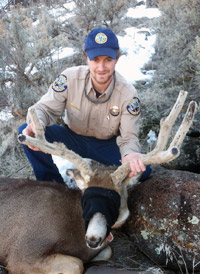 For ten years hunters and residents of western Colorado, near the north fork of the Gunnison River have been reporting mule deer with strange antlers to the Colorado Division of Wildlife. A Colorado Division of Wildlife press release says: “In these male animals the antlers grow in odd shapes, never develop fully and do not lose their velvet.”
For ten years hunters and residents of western Colorado, near the north fork of the Gunnison River have been reporting mule deer with strange antlers to the Colorado Division of Wildlife. A Colorado Division of Wildlife press release says: “In these male animals the antlers grow in odd shapes, never develop fully and do not lose their velvet.”
These mule deer with the fuzzy, misshapen antlers have been called “cactus bucks.”
The cause of the deformity is a mystery, although division biologists believe that hemorrhagic disease is to blame.
Colorado Parks and Wildlife biologists recently collared eight infected animals and will follow them to see whether they shed their “cactus” antlers or grow new, normally developed ones in the future.
Read the Colorado Parks and Wildlife press release here. (So far news outlets have just reprinted the press release.)
In other cervid disease news: Three wild deer have tested positive for bovine tuberculosis in Michigan (at the top of the mitten’s index finger), according to an article in USA Today. Humans are not at risk, according to the State of Michigan’s emerging disease information. However, wild deer populations are at risk, as is the status of the region’s livestock, which may face greater regulations.
Read the story in USA Today, here.
The Michigan emerging disease info on bovine TB is here.
Photo: Kyle Banks, district wildlife manager for Colorado Parks and Wildlife in the Hotchkiss area, holds one of the “cactus bucks” collared in January 2012 as part of a five-year study. Courtesy of Colorado Parks and Wildlife.
